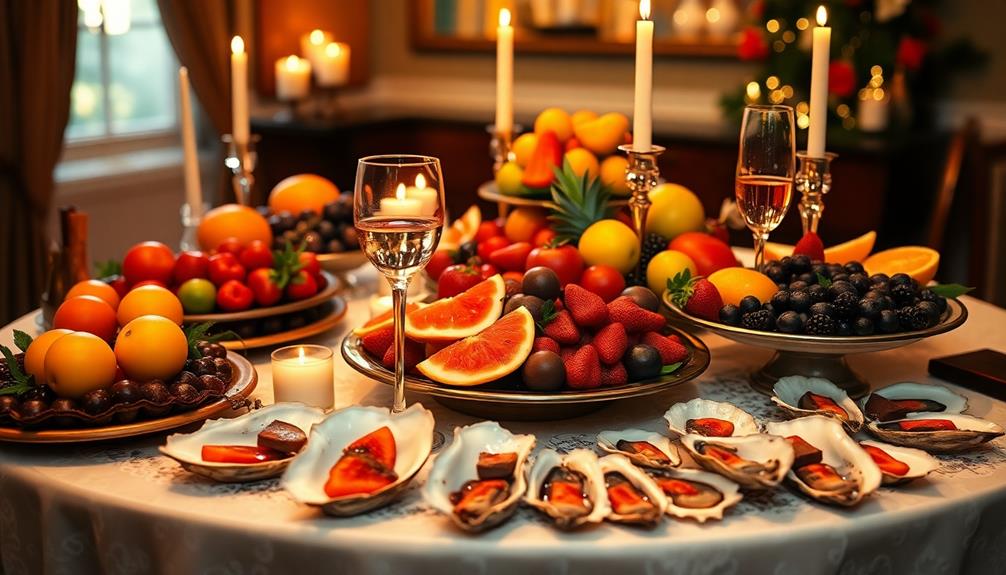Some folks are supertasters because they have more taste buds than others, and this makes flavors stronger! About 25-30% of people, especially women and some ethnic groups, are supertasters. They carry a special gene called TAS2R38, which means they can taste bitterness more intensely. So, if you find broccoli or coffee bitter, you might be one! Supertasters often prefer sweeter or saltier foods, which can make food choices more exciting but tricky. If you're curious about what it's like to have super tasting powers, there's a lot more to discover about this flavorful world!
Key Takeaways
- Supertasters have heightened taste sensitivity due to a higher density of taste buds, averaging 35-60 papillae per six-millimeter section.
- The TAS2R38 gene significantly influences taste sensitivity, particularly to bitter flavors, with variants inherited among family members.
- Approximately 25-30% of the population are supertasters, with a higher prevalence in women and specific ethnic groups.
- Dietary preferences of supertasters often lead to aversions to bitter foods, resulting in a narrower range of food choices.
- Testing methods like PROP sensitivity tests and visible papillae counting can help identify supertaster status.
Definition of Supertasters
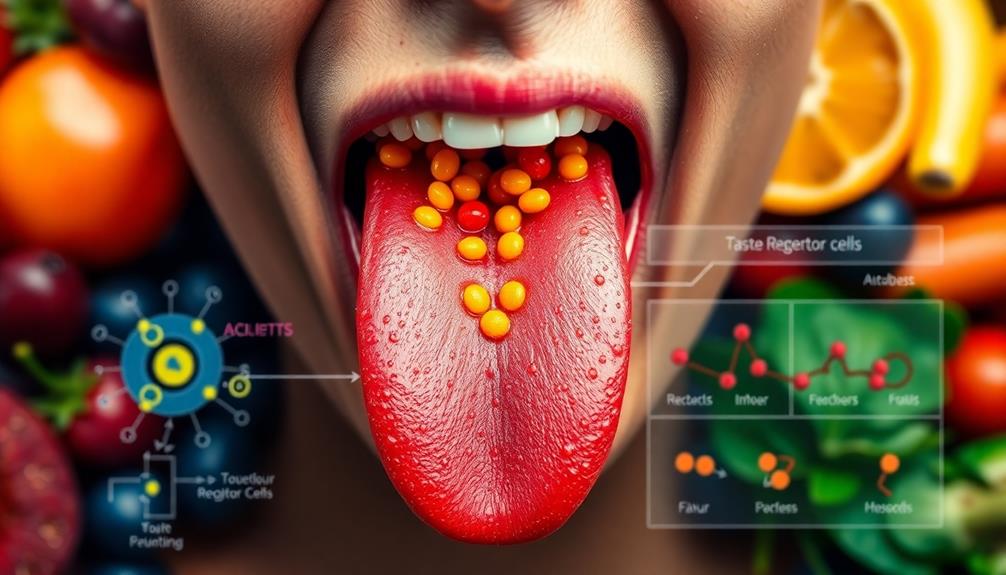
Supertasters stand out due to their heightened taste sensitivity, which stems from having a greater number of fungiform papillae on their tongues. These tiny bumps are like little taste buds, and supertasters have 35-60 per six-millimeter section, while non-tasters have only 15 or fewer. This difference makes tasting food an exciting adventure for supertasers!
For instance, they might experience the rich blend of spices in a Mushroom Masala more intensely than others, enhancing their appreciation for its earthy flavors. Around 25-30% of people are supertasters, and you might be surprised to know that women and certain ethnic groups, including those from Asia, Africa, and South America, are more likely to have this special ability.
Because of their unique taste perception, supertasters often experience flavors more intensely than others.
However, this heightened sensitivity comes with some challenges. Many supertasters have a strong dislike for bitter foods like broccoli, spinach, and grapefruit. These aversions can shape their eating habits and make mealtime a little tricky. Additionally, supertasters may struggle with foods that have strong flavors, leading to a more limited palate. This can complicate not only their nutritional intake but also their enjoyment of diverse cuisines. Understanding food allergies becomes even more crucial for supertasters, as their heightened taste sensitivity might be confused with adverse reactions, making it important to differentiate between taste preferences and actual allergens.
Here's a fun summary of supertasters:
- They've more fungiform papillae.
- They taste flavors more vividly.
- They often avoid bitter foods.
Isn't it fascinating how our taste buds can be so different? Enjoy your next meal, and think about the amazing world of flavors out there!
Genetic Factors Involved

Did you know that being a supertaster is all about your genes? The TAS2R38 gene plays a huge role in how you taste bitter flavors, and it's linked to having more taste buds on your tongue.
This fascinating genetic mix not only explains why some folks are super sensitive to flavors, but it also shows how these traits can be passed down through families!
Curiously, the heightened sensitivity can influence food preferences, making some people more inclined to enjoy dishes with bold flavors, such as Cumin Lamb, while others may shy away from them.
TAS2R38 Gene Influence
The TAS2R38 gene plays an essential role in shaping your taste sensitivity, especially when it comes to bitter flavors. If you have a specific variant of this gene, you might be one of the lucky supertasters! This means you experience bitterness more intensely than most people. Isn't that interesting?
Supertasters might find that their heightened sensitivity influences their enjoyment of certain foods, making them more selective about what they eat. For example, they may prefer dishes that celebrate fresh ingredients, like a Grilled Peach and Burrata Salad, which combines sweet and creamy flavors to create a delightful balance.
Here are some fun facts about the TAS2R38 gene and supertaster status:
- Heightened Awareness: Supertasters often avoid bitter foods like broccoli and spinach, which might make family dinners a little tricky!
- Prevalence: About 25% of the population carries this gene variant, with a higher percentage in women.
- Dietary Choices: Your taste buds can influence what you love or dislike about food, making meals a unique experience for you.
Understanding how the TAS2R38 gene affects your taste can help explain why you might love or loathe certain flavors.
Taste Bud Density Variations
Taste bud density is a fascinating aspect of your genetic makeup that directly influences how you perceive flavors. Did you know that the number of taste buds you have can change how you enjoy food? For instance, individuals with a higher taste bud density might experience more intense flavors, making certain dishes, like the rich and flavorful Muamba De Galinha, particularly enjoyable or overwhelming.
Here are some fun facts about taste bud density:
- Supertasters have a higher density of taste buds, usually 35-60 in a tiny section of their tongue.
- Non-tasters might've only 15 or fewer taste buds in the same space!
- About 25-30% of people are classified as supertasters, with more women and individuals from Asian, African, and South American backgrounds in this group.
- The TAS2R38 gene plays a big role in how sensitive you're to bitter flavors.
These differences in taste bud density are genetic, meaning they're passed down through families. If you're a supertaster, you might find some foods too strong or bitter, while others may love those flavors!
Understanding these variations helps explain why some people enjoy foods like Brussels sprouts, while others can't stand them. So next time you enjoy a meal, think about your unique taste bud journey!
Inheritance Patterns Explained
Understanding your taste preferences can lead to a deeper appreciation of food, but it's not just about personal experience; genetics plays a significant role in how these traits are inherited. You might be curious about why you or your family members react differently to certain flavors. Well, this is where the TAS2R38 gene comes into play!
Notably, the diverse flavors found in various cuisines, such as the rich and unique tastes of Brazilian Cuisine, can also influence one's taste sensitivity.
- Supertasters: About 25-30% of people are supertasters, meaning they experience tastes more intensely.
- Inheritance: This trait follows Mendelian genetics, so if your parents are supertasters, there's a good chance you could be one too!
- Taste Sensitivity: Different versions of the TAS2R38 gene could enhance your ability to taste bitter flavors, making food experiences more vibrant.
- Genetic Variability: Not all supertasting traits come from TAS2R38 alone; other genetic factors might also be at work!
- Environmental Influence: Your surroundings can affect how these taste traits show up, creating a delightful mix of flavors in your life.
Identifying Supertaster Traits
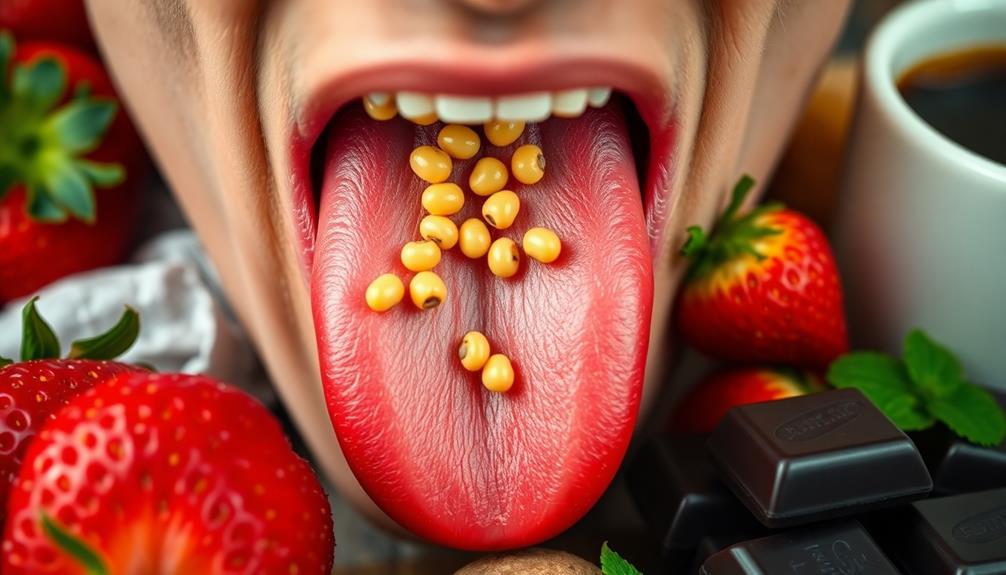
How can you tell if you're a supertaster? It's fun to find out! Supertasters have special traits that make their taste buds extra sensitive. This heightened sensitivity can make culinary experiences particularly vibrant, allowing them to appreciate the nuances in dishes like Zaru Soba or Yesiga Tibs.
Here are some signs that you might be one:
- You notice a lot of flavor in foods that others don't.
- You often dislike bitter foods like broccoli, spinach, or coffee.
- You might prefer sweeter, saltier, or fattier flavors to balance out bitterness.
- You have a higher number of taste buds on your tongue than your friends.
About 25-30% of people are supertasters, and you might be among them! You can check your status at home. For example, try using blue food coloring to count your taste buds. If you see more than 30 in a six-millimeter section, you're likely a supertaster!
Another fun method is to test your sensitivity to PROP (propylthiouracil). If it tastes really bitter to you, you've got supertaster vibes!
Dietary Preferences of Supertasters

Maneuvering the culinary world can be quite different for supertasters, who often have distinct dietary preferences shaped by their heightened taste sensitivity. You might find they steer clear of bitter foods like broccoli, spinach, and coffee. Instead, they lean towards sweeter, saltier, or fatty flavors to make their meals more enjoyable.
Here's a quick look at common dietary preferences among supertasters:
| Preference Type | Foods They Enjoy |
|---|---|
| Sweet | Chocolate, fruits |
| Salty | Potato chips, pretzels |
| Fatty | Cheese, avocados |
| Bitter Foods to Avoid | Broccoli, coffee |
| Nutrient Risks | Lack of cruciferous veggies |
Such choices can affect their overall calorie intake, often leading to lower body weight. However, it's crucial to recognize that this can also result in nutrient deficiencies. If you're a supertaster, you might need to find creative ways to include essential veggies in your diet. Remember, it's all about balancing those tasty flavors while keeping your meals fun and nutritious! Exploring new recipes can be an exciting adventure for you and your family!
Impact on Eating Habits

If you're a supertaster, you might notice that your food preferences are a bit different from others.
You might steer clear of bitter veggies like broccoli and spinach, which can make it tricky to get all the nutrients your body needs.
Exploring flavorful Indonesian dishes like Kue Putu can provide a delightful alternative that balances taste and nutrition.
But don't worry, there are fun ways to spice things up, like adding a sprinkle of salt or a dash of sweetness to make those foods more enjoyable!
Selective Food Preferences
Selective food preferences considerably shape the eating habits of supertasters, who often avoid certain foods due to their heightened sensitivity to taste. You might find it interesting to know that supertasters have unique taste buds, making bitter flavors more intense for them. This often leads to some specific food choices:
- They tend to avoid bitter vegetables like broccoli and Brussels sprouts.
- They often prefer sweeter, saltier, or fatty foods to mask unpleasant tastes. For example, they might enjoy flavorful dishes like Chilaquiles that offer a combination of comforting and zesty flavors.
- Their picky eating habits result in a narrower range of food preferences.
- They're more likely to reach for high-salt foods, which can lead to increased salt consumption.
Because of their aversion to bitter tastes, supertasters might miss out on essential nutrients found in those cruciferous veggies.
It's important to understand that while those tasty treats can be tempting, a balanced diet is key to staying healthy.
Encouraging supertasters to explore different flavors, perhaps by adding dips or spices, can help expand their food preferences.
Nutrient Absorption Challenges
Supertasters' unique taste sensitivities can greatly impact their nutrient absorption, leading to challenges in maintaining a balanced diet. If you're a supertaster, you might find yourself steering clear of bitter vegetables like broccoli and spinach, which are often celebrated for their nutritional benefits. While these foods are packed with vitamins, avoiding them can lead to vitamin deficiencies.
Additionally, you may miss out on flavorful dishes like Pasta With Tomato Sauce, which can provide essential nutrients without overwhelming bitterness.
Here's how it affects your eating habits:
- Selective Taste: You may prefer sweeter or saltier foods to mask bitterness, which often means choosing less nutritious options.
- Body Weight: This selective eating can keep your body weight lower, but it also risks missing out on essential nutrients.
- Fiber Intake: You might consume less fiber, impacting your digestive health and possibly increasing the risk of colon cancer.
- Salt Use: Sometimes, you might add extra salt to make food more enjoyable. But be careful! Too much salt can raise your chances of heart disease and hypertension.
Staying healthy is important, so finding ways to include a variety of flavors can help you enjoy a balanced diet while keeping your taste buds happy!
Flavor Modification Techniques
Many supertasters find that modifying flavors is essential for enjoying a variety of foods while maintaining a balanced diet. For instance, incorporating festive dishes like Graveyard Taco Dip can make meals more enjoyable, especially during seasonal gatherings.
Here are some fun flavor modification techniques you can try:
- Add Sweetness: Mixing in a touch of honey or sugar can help mask bitterness in foods like Brussels sprouts.
- Salt it Up: A sprinkle of salt can reduce the unpleasant taste of bitterness, especially in cheesy dishes.
- Creamy Goodness: Incorporating creamy sauces or dressings makes veggies more enjoyable and adds a delightful taste.
- Spice it Right: Using spices can elevate flavors, distracting your taste buds from the bitter notes.
These flavor masking strategies are vital for supertasters. Your heightened taste papillae might make you sensitive to bitterness, but don't worry! You can still enjoy nutrient-rich foods.
By adding sweet, salty, or fatty components, you can transform your meals into a delightful experience. With a little creativity, you can balance your taste sensitivity while ensuring your meals are both tasty and nutritious.
Health Benefits of Supertasting
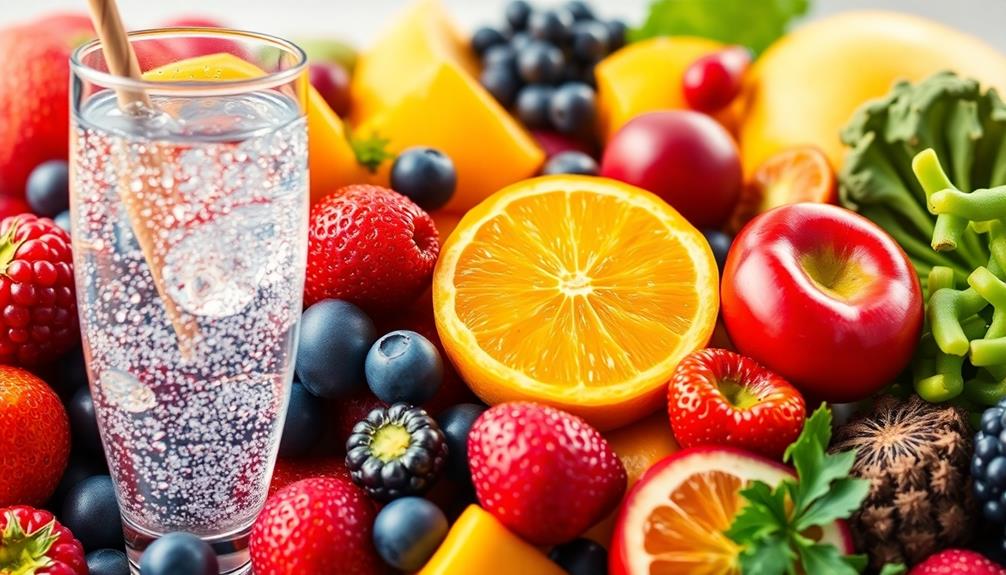
With a heightened sensitivity to taste, individuals who are supertasters can enjoy a range of flavors that often leads to healthier eating habits.
Your taste buds are like tiny super-sensors, helping you appreciate the natural goodness in foods. This can be a big win for your health!
Here are some health benefits of being a supertaster:
- Lower Cravings: Supertasters often crave fewer unhealthy, high-calorie foods, which can help keep obesity at bay.
- Flavor Variety: You might find joy in less sweet or fatty foods, making it easier to stick to a healthy diet.
- Nutrient-Rich Choices: By avoiding some bitter foods, you'll seek out more flavorful, nutrient-packed options.
- Increased Meal Enjoyment: The intense flavors you experience can make meals more satisfying, encouraging you to stick with healthy choices.
Risks Associated With Supertasting
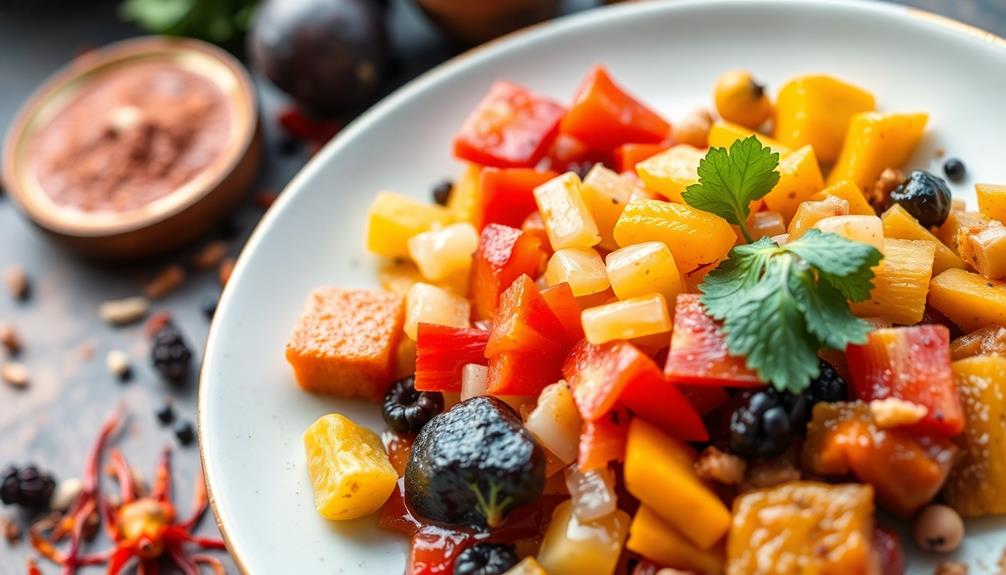
While being a supertaster can sound fun, it does come with some risks you mightn't think about!
You may find yourself avoiding certain healthy foods, like bitter veggies, which could lead to nutrient deficiencies.
Plus, if you love salty snacks, you might be munching your way toward higher salt intake, which isn't the best for your heart!
Nutrient Deficiencies Risks
Supertasters face significant risks of nutrient deficiencies due to their aversion to bitter foods like broccoli and spinach. This selective eating can lead to missing out on important vitamins and minerals.
Here are some key nutrients you might be lacking:
- Vitamin A – Important for eye health.
- Vitamin C – Boosts your immune system.
- Vitamin K – Essential for blood clotting.
- Folate – Essential for cell growth and metabolism.
When you avoid cruciferous vegetables, you mightn't just miss the bitterness but also critical plant compounds that protect your body.
Limiting your diet can make it tough to get enough fiber, which is important for a happy tummy! Plus, if you stick to sweeter foods, you could be missing out on a whole world of flavors and nutrients.
Increased Salt Consumption
Many people who experience supertasting find themselves drawn to high-salt foods as a way to enhance flavors and mask the bitterness of certain items.
If you're a supertaster, you might notice that you enjoy salty snacks and dishes more than others do. This preference can lead to increased salt consumption, which isn't always a good thing!
Here are some important points to take into account:
- Supertasters often taste bitterness more intensely, making salty foods more appealing.
- This can result in eating more salt than recommended, which may lead to health issues like hypertension and heart disease.
- While you might skip adding salt during cooking, it's easy to consume more than you think through naturally salty flavors.
To enjoy your meals and keep your health in check, keep in mind these tips:
- Experiment with herbs and spices to add flavor without salt.
- Try balancing bitter foods with sweeter ones to reduce the need for salt.
- Drink plenty of water to help with taste balance.
Limited Dietary Variety
A limited dietary variety can pose significant health risks for those who experience supertasting. Supertasters have highly sensitive taste buds, making them more likely to avoid certain foods. This can lead to a diet lacking in important nutrients.
Here are some potential risks:
- Vitamin Deficiencies: Skipping bitter veggies like broccoli and spinach can mean missing out on vitamins A, C, and K.
- Low Fiber Intake: Avoiding fiber-rich foods may increase the risk of colon cancer.
- High Sodium Levels: To counteract bitterness, super tasters often add extra salt, which could lead to hypertension or heart disease.
- Weight Gain: A preference for sweet and fatty flavors can result in high-calorie meals, impacting overall health.
Flavor Masking Techniques
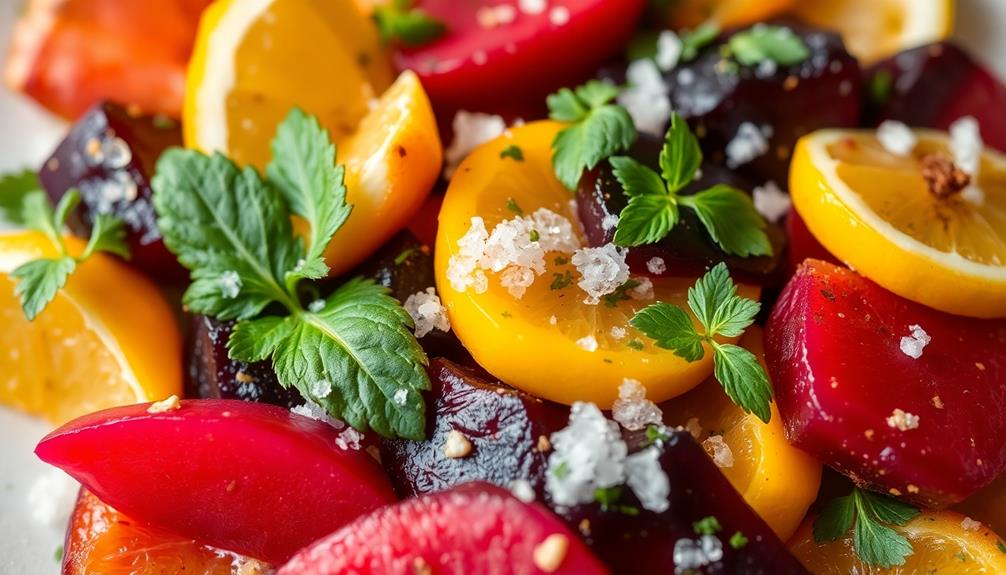
When faced with the overwhelming bitterness of certain foods, flavor masking techniques can be a game changer for supertasters. You can transform your meals by adding sweet, salty, or fatty elements to those bitter bites you might usually avoid.
Here are some fun flavor masking tips:
- Sprinkle Salt: A pinch of salt can brighten flavors and reduce bitterness in vegetables.
- Add Sweetness: Try drizzling honey or using sweet dressings to make veggies more appealing.
- Incorporate Fat: Creamy cheeses or rich creams can create a delicious balance, making even the toughest greens enjoyable!
Using these techniques allows supertasters to enjoy a wider variety of foods while still meeting their nutritional needs.
You'll find that masking bitterness not only enhances the taste but also helps you feel good about what you eat.
Testing for Supertaster Status

Understanding whether you're a supertaster can enhance your culinary experiences and help you navigate flavor profiles more effectively. Testing for supertaster status can be fun and informative! Here are some ways to find out:
- Count Your Papillae: Look at your tongue. If you see more than 30 visible fungiform papillae, you might be a supertaster!
- Blue Food Coloring Test: Dye your tongue with blue food coloring, then use a magnifying glass to spot your taste buds more easily.
- PROP Taste Test: Try tasting PROP (propylthiouracil). If it's extremely bitter to you, congratulations! You're likely a supertaster.
- Professional Assessment: For more accurate results, consider getting tested by a professional, who might use various methods to determine your taste sensitivity.
Getting to know your taste buds can lead to exciting culinary adventures.
Whether you love savoring flavors or just want to impress your friends with your newfound knowledge, testing for supertaster status is a delightful journey.
Ongoing Research and Findings
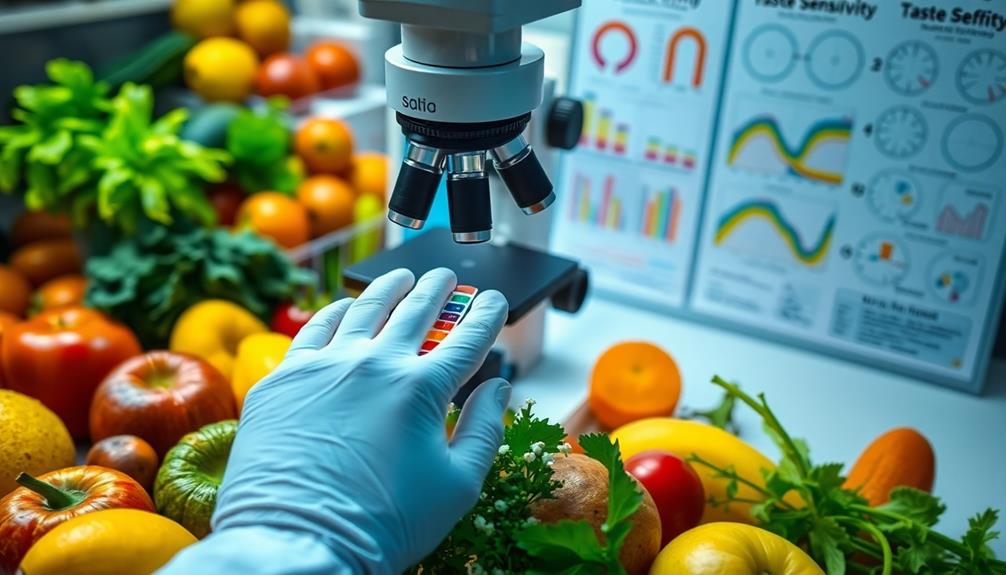
Recent research has shed light on the genetic and physiological factors that contribute to supertasting, particularly the role of the TAS2R38 gene in determining sensitivity to bitter flavors. This gene plays a big part in the supertaster phenotype, making some people more sensitive to tastes than others.
Here are some exciting findings:
- Taste Buds Galore: Supertasters have a higher density of fungiform papillae, boasting 35 to 60 taste buds in just a six-millimeter section of their tongue! Non-tasters? They usually have 15 or fewer.
- Dietary Choices: Because of their heightened taste sensitivity, supertasters often avoid bitter foods like certain vegetables. Instead, they might lean towards sweeter or saltier options, which can mask that bitterness.
- Health Implications: Researchers are looking at how avoiding bitter veggies could lead to nutrient deficiencies and how their salt preferences might affect heart health.
- New Methods: Exciting new techniques, like irritant bitter tasting (iBT) and thermal tasting (TT), are helping scientists understand supertasting better.
These ongoing studies are helping us learn more about what it means to be a supertaster!
Frequently Asked Questions
What Causes Someone to Be a Supertaster?
Being a supertaster stems from genetic factors that influence your taste perception. If you have a higher density of taste buds, you'll likely experience stronger flavors, especially bitterness, making you more sensitive to certain foods.
Is Being a Supertaster Genetic?
Yes, being a supertaster is genetic. If you inherit specific traits from your parents, you might experience heightened sensitivity to flavors, especially bitter ones, due to variations in your taste-related genes.
What Is the Evolutionary Reason for Supertasters?
Imagine your ancestors foraging for food, avoiding bitter plants. This heightened sensitivity to flavors evolved as a survival tactic, helping you detect toxic substances and safely select nourishing, ripe fruits in a dangerous environment.
Who Is More Likely to Be a Supertaster?
You're more likely to be a supertaster if you're female or belong to certain ethnic groups, like Asian, African, or South American descent. Genetic factors and the density of taste buds also play a significant role.
Conclusion
In the great garden of flavors, supertasters are like skilled gardeners, carefully selecting the ripest fruits and avoiding the bitter weeds. Their unique taste buds turn every meal into a delightful adventure, making food a treasure hunt! While they might face some challenges, like avoiding overly spicy dishes, their journey through taste brings joy and excitement to family meals. So, whether you're a supertaster or not, remember that every bite can be a chance to explore and enjoy together!






